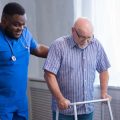Understanding the Joint Replacement Procedure
If you or a loved one are considering joint replacement surgery, it’s important to know what to expect, especially for older adults. Joint replacement is a common procedure in the United States and can help improve mobility and reduce pain for many people. However, understanding the basics of the surgery—and what happens before you even get to the operating room—can help you feel more prepared and confident.
What Is Joint Replacement?
Joint replacement surgery involves removing damaged or worn-out parts of a joint (most often the hip or knee) and replacing them with artificial components made from metal, plastic, or ceramic materials. This new joint is designed to function like your natural joint so you can move more comfortably.
Why Do Older Adults Need Joint Replacement?
As we age, joints can wear down due to arthritis, injury, or simply years of use. Many older adults choose joint replacement when pain keeps them from doing everyday activities like walking, climbing stairs, or even getting out of a chair.
Before Heading Into the Operating Room: What to Expect
Preparing for joint replacement surgery involves several steps. Knowing what’s ahead helps you set realistic expectations and reduces anxiety. Here’s an overview:
| Step | What Happens |
|---|---|
| Initial Consultation | Your orthopedic doctor will review your medical history, examine your joint, and order X-rays or other imaging tests. |
| Pre-Surgery Testing | You may need blood work, heart tests (like EKG), and other exams to ensure youre healthy enough for surgery. |
| Discussion of Risks & Benefits | Your healthcare team will explain potential benefits, risks, and what recovery will look like for someone your age. |
| Pre-Op Instructions | You’ll get instructions on when to stop eating before surgery, which medications to take or avoid, and how to prepare your home for recovery. |
Important Questions to Ask Your Surgeon
- How long will I stay in the hospital?
- What kind of anesthesia will I receive?
- How long does the recovery process usually take for someone my age?
- Will I need physical therapy after surgery?
- What should I do at home to make recovery easier?
A Quick Tip
If you have family or friends who can help after your surgery, talk with them ahead of time about transportation, meals, and support with daily tasks. Being prepared makes recovery smoother and less stressful.
2. Anticipating the Recovery Timeline
Understanding the Road to Recovery
Recovering from joint replacement surgery is a journey, especially for older adults. It’s important to set realistic expectations about how long it will take before you’re back on your feet and feeling like yourself again. Everyone heals at their own pace, but there are some general timelines and milestones you can keep in mind as you plan your recovery.
Typical Recovery Milestones
Here’s a simple breakdown of what most older adults can expect during joint replacement recovery:
| Time After Surgery | What to Expect |
|---|---|
| First Few Days | Hospital stay (usually 1-3 days), starting gentle movement with help, managing pain and swelling, learning to use a walker or crutches. |
| Week 1-2 | Returning home, continuing physical therapy, gradually moving more around the house, increasing independence in basic activities like dressing and using the bathroom. |
| Weeks 3-6 | Improved strength and range of motion, walking with less assistance, doing light household tasks, possibly driving short distances if cleared by your doctor. |
| Weeks 7-12 | Most people are able to walk without a cane or walker, resume many normal routines, and enjoy increased comfort during daily activities. |
| 3-6 Months | Nearing full recovery for most daily life needs—walking further distances, going out for errands, and enjoying hobbies with minimal discomfort. |
| Up to 1 Year | Some lingering stiffness or mild discomfort may persist, but most older adults feel confident in their new joint and regain independence in almost all activities. |
When Can You Expect Independence?
Many older adults find that they can manage most of their personal care—like bathing, getting dressed, and preparing simple meals—within two to four weeks after surgery. However, regaining full independence for things like driving or returning to community activities often takes about six weeks to three months. Remember: your progress depends on your health before surgery, the type of joint replaced, and how closely you follow your rehab plan. Patience and consistency are key!
![]()
3. Physical Therapy and Safe Mobility
The Role of Physical Therapy in Joint Replacement Recovery
Physical therapy is a cornerstone of recovery after joint replacement surgery, especially for older adults. It helps restore strength, flexibility, and balance so you can return to your daily activities safely. In the United States, physical therapists are licensed professionals who design exercise programs tailored to your needs and progress.
What to Expect from Physical Therapy
| Phase | Activities | Goals |
|---|---|---|
| Early Recovery (First Few Days) | Gentle range-of-motion exercises, walking with assistive devices (walker or cane) | Prevent stiffness, reduce swelling, begin safe movement |
| Ongoing Rehab (Weeks 2-6) | Strengthening exercises, balance training, increased walking distance | Improve muscle strength, regain independence at home |
| Long-Term Recovery (After 6 Weeks) | Advanced exercises, practice stairs or curbs, community mobility tasks | Return to regular activities, improve confidence moving outside the home |
Practical Tips for Safe Movement at Home and in the Community
- Use assistive devices: Don’t rush to give up your walker or cane. They help prevent falls until you are steady on your feet.
- Remove tripping hazards: Clear pathways by removing loose rugs and clutter at home. Make sure rooms are well-lit.
- Sit in sturdy chairs: Use chairs with armrests to make sitting and standing easier and safer.
- Take it slow: Allow extra time when moving from one place to another—especially when going out into the community.
- Ask for help: Don’t hesitate to ask family or friends for support with groceries, transportation, or errands during your recovery.
- Practice new skills: Your therapist may teach you how to use stairs safely or get in and out of a car. Practice these skills under supervision before trying them alone.
If You Notice Pain or Swelling…
If you experience new pain, swelling, or difficulty moving, contact your healthcare provider or physical therapist right away. Early attention can prevent complications and keep you on track toward recovery.
4. Pain Management and Medication
Understanding Pain After Joint Replacement
After joint replacement surgery, it’s normal to experience pain and discomfort. The good news is that there are many ways to manage pain, especially in the American healthcare system. Setting realistic expectations about pain can help older adults feel more confident as they recover.
Common Pain Management Strategies
| Pain Management Method | Description | When It’s Used |
|---|---|---|
| Opioid Medications | Prescription pain relievers that help manage severe pain right after surgery. | Short-term use only, usually in the first few days after surgery. |
| Non-Opioid Medications | Includes acetaminophen (Tylenol) and NSAIDs like ibuprofen. These reduce mild to moderate pain and inflammation. | Can be used alone or along with other methods, often after initial recovery period. |
| Ice Therapy | Applying ice packs to the surgical area helps reduce swelling and numb pain. | Several times a day for 15-20 minutes each session. |
| Physical Therapy | Gentle exercises guided by a physical therapist help restore movement and decrease stiffness, which can reduce pain over time. | Starts soon after surgery and continues through recovery. |
| Relaxation Techniques | Methods like deep breathing, meditation, or listening to soothing music can distract from pain and lower stress levels. | Anytime you’re feeling anxious or uncomfortable. |
The Role of Opioids: Responsible Use Matters
Opioids can be very effective for controlling strong pain right after surgery. However, because they can be habit-forming, doctors in the United States now prescribe them carefully. Most people only need opioids for a few days. Your healthcare team will give clear instructions on how much to take and when to stop. Always follow these directions and talk to your doctor if you have concerns about side effects or dependency.
Non-Pharmacological Approaches
Pain management isn’t just about medication. Non-drug approaches play an important role in recovery too. Using ice packs, elevating your leg, participating in physical therapy, and practicing relaxation techniques all help reduce discomfort without extra medication. These strategies not only relieve pain but also support faster healing and better long-term outcomes.
What Should You Tell Your Healthcare Team?
If your pain feels out of control or lasts longer than expected, let your medical team know right away. Good communication ensures you get the best care possible as you heal from joint replacement surgery.
5. Support Systems: Family, Friends, and Community Resources
How to Leverage Your Support Network for a Smoother Recovery
Recovering from joint replacement surgery at home can feel overwhelming, but you don’t have to do it alone. Leaning on family, friends, and community resources makes a big difference in your recovery journey. Here’s how you can get the support you need to heal safely and confidently.
The Role of Family and Friends
Your loved ones are an important part of your recovery team. They can help with daily tasks, provide emotional encouragement, and keep you motivated. Don’t hesitate to ask for help—you might be surprised how eager people are to lend a hand!
| Type of Help | Examples |
|---|---|
| Practical Assistance | Grocery shopping, meal prep, medication reminders, transportation to appointments |
| Emotional Support | Regular check-ins, companionship, encouragement during tough days |
Community Resources That Make a Difference
In the U.S., many local organizations offer services designed specifically for older adults recovering from surgery. These resources help you stay independent while ensuring you have what you need at home.
Outpatient Rehab Centers
Many people continue physical therapy at outpatient rehab centers after leaving the hospital. These facilities offer supervised exercise programs and expert guidance to help you regain strength and mobility.
Senior Centers
Your neighborhood senior center is more than just a gathering place. Many centers offer exercise classes tailored for joint health, educational workshops about recovery, social events to keep your spirits up, and even transportation assistance.
Meal Delivery Services
If cooking is difficult during recovery, meal delivery programs like Meals on Wheels or local church groups can make sure you have healthy food without extra stress.
| Community Resource | How It Helps |
|---|---|
| Outpatient Rehab | Guided exercises, safety checks, progress monitoring |
| Senior Center | Social interaction, special classes, resource referrals |
| Meal Delivery | Nutritional support, less time on chores, peace of mind for families |
Tips for Getting the Most Out of Your Support System
- Create a contact list of family members and friends who can help with specific needs.
- Reach out to your local Area Agency on Aging for information about available resources in your community.
- Keep open communication with your healthcare team—let them know if you need extra support at home.
You’re Not Alone—Let Others Help You Heal!
Your road to recovery will be smoother and safer when you take advantage of the people and programs around you. Remember: asking for help is a sign of strength and wisdom as you work toward regaining your independence after joint replacement surgery.


